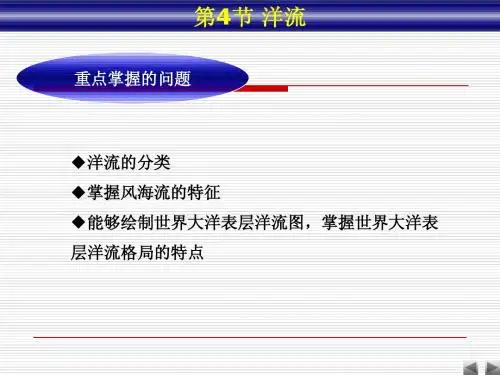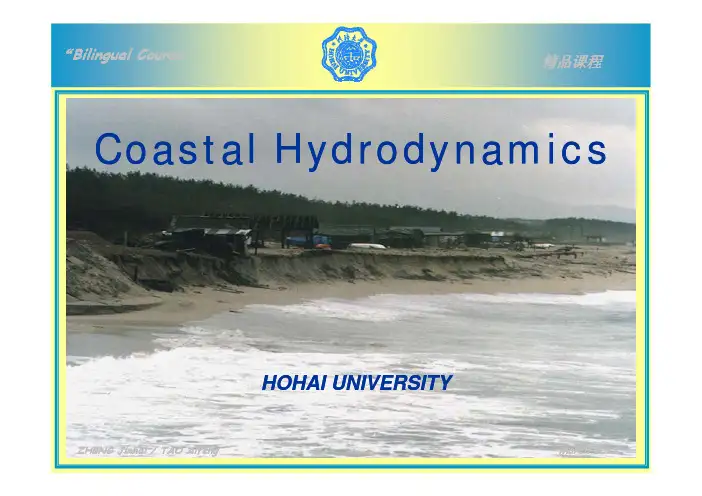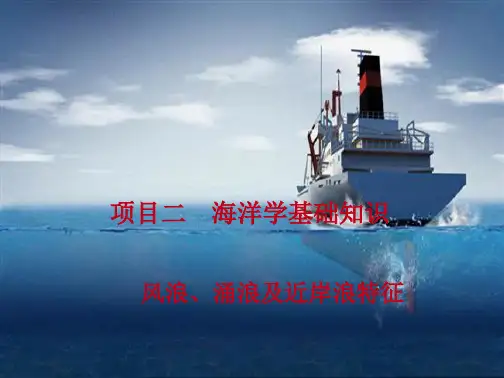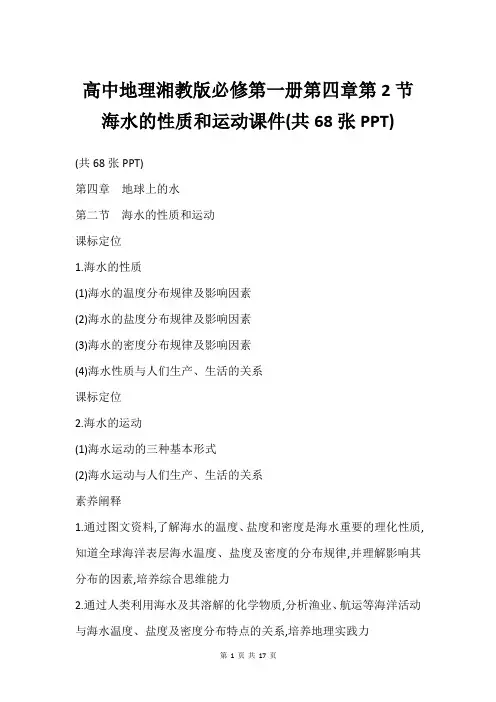第4章 近岸水流运动特性(4版)PPT课件
- 格式:ppt
- 大小:1.96 MB
- 文档页数:62



“Bilingual Course”精品课程Coastal Hydrodynamics C t l H d d iHOHAI UNIVERSITYAifeng March 2013 / TAO AifengZHENGZHENG JinhaiJinhai/ TAOChapter 3 WA VE TRANSFORMATIONS Stating ocean wave characteristicsStating transformations of wavesStating transformations of wavesentering shallow waterChapter 4 NEARSHORE CURRENTS Ch 4Stating types of currentsradiation stress(辐射应力) Stating concept of radiation stressStating concept ofwave set--up(波浪增水) Stating phenomena of wave setStating phenomena ofwave set--down (波浪减水)andand wave setlongshoreStating characteristics ofStating characteristics of longshorecurrents (沿岸流)currentsOutline of Currents4.1 Outline of Currents41O tli f C t §4.11.Ocean currents2. 2. Tidal currentsTidal currentsNearshore currents 3. 3. Nearshore currents3Nearshore currentsOcean currents1. Ocean currents1.In the ocean, there exit currents of almost constant direction and speed through the year. constant direction and speed through the year Ocean currents are mainly generated by windand gradientdrift currents andgradient and are classified as drift currentsand are classified as, or density currents and compensationcompensation currentsor density currents andcurrents, or density currents andcurrents according to generation mechanism. They are also classified aswarm or cold currents They are also classified as warm or cold currents depending on whether their temperatures ared di h th th i t thigher or lower than those of thegneighboring ocean region.Tidal currents2.2. Tidal currentsTidal currents are induced by the horizontalmovement of the sea water together with tidal movement of the sea water together with tidalmotion. The motion of tidal currents has periodswhich correspond to their tidal constituents.hi h d t th i tid l tit tTidal currents occasionally play an importanty p y prole in the nearshore region. They are easilyinfluenced by the sea bottom and coastal influenced by the sea bottom and coastaltopography, thus they have strongly localizedcharacteristics. Hence it is rather difficult toestablish a clear relationship between tides establish a clear relationship between tidesand tidal currents in general.Nearshore currents3. Nearshore currents3.The nearshore current consists of the mass transport induced by wave action, the longshore current and rip currents.There are two wave current and rip currents.There are two wave--wave induced current systems in the nearshore zone. These are:ll i l ti t f i t d ¾ a cell circulation system of rip currents and associated longshore currents,associated longshore currents,¾longshore currents produced by an oblique wave approach to the shoreline.p,g gThe slow mass transport, the feeding longshore currents, and the rip currents taken together form a cell circulation system in the nearshore zone.zoneIt is well known that whenIt is well known that whenwaves approach a straightcoastline at an oblique angle, a longshore current is established l h t i t bli h dow g p e o e co s e flowing parallel to the coastlinein the nearshore zone.It is seen that under anIt is seen that, under an oblique wave approach withboth systems present, the current pattern becomest tt by, asymmetrical, with the zeroupdrift velocity node justvelocity node just updrift from the rip current and a f th i t dy g velocity increase extendingfrom there to the next rip current.The cell circulation is important in renewing thenearshore zone and removing water in thewater in the nearshorepollutions such as mud and sewage that may be dumped there.d d thThe current is particularly significant The longshorelongshore current is particularly significant Thein that it is responsible for the net transport of in that it is responsible for the net transport of sand or other beach material along the shore. sand or other beach material along the shore.Fishermen and others living near the coasthave been aware of these currents for severalyears through their experiences in nearshorewater.waterJohnson considered the longshore current andundertow as wave--induced currents in his undertow as waveclassic treatise. He attempted to treat coastal l i i H d l sediment movement and coastal processes by sediment movement and coastal processes by regarding these currents as the media of sediment transport.In 1941, Shepard et al. published a paper entitled In1941Shepard et al published a paper entitled “Rip Currents”, in which they defined rip currents as currents in the offshoreward direction which return the sea water transported di ti hi h t th t t t dyshoreward by wave action.The function of rip currents in carrying away fine suspended sediment particles from the surf zoned d di t ti l f th fp g pto deeper water region seems to be important in the overall pattern of sediment movement in the nearshore area.The rip current is the dark patch. There is intense wave breaking on both sides of the rip currents with little breaking within the deeper rip channel, where bubbles are advected seaward.In 1949 Putnam, Munk and Traylor proposedformulae to evaluate the mean velocity oflongshore currents. Their results encouraged l h t Th i lt dresearchers to undertake further studies to researchers to undertake further studies to clarify the longshore sediment transport clarify the longshore sediment transportec a s a d to est ate t e o gs o e mechanism and to estimate the longshore ptransport rate.In 1962, LonguetLonguet--Higgins and Stewart presented In 1962,In1962Longuet Higgins and Stewart presented the concept of radiation stress and applied it to analyze various water wave problems such as current and wave--wave interactions. wave--current and wavewaveSince the end of the 1960’s, the application ofSi th d f th1960’th li ti f the radiation stress concept has been extended the radiation stress concept has been extendeddown, wave set--up,lonshoreup, lonshore to such as wave set--down, wave setto such as wave setnearshore currents, rip currents, and thecurrents, rip currents, and the nearshore current system.Radiation Stress §4.24.2 Radiation Stress1.Definitionxpressions2. Expressions2. E3. Applicationspplications3. ApplicationsA3Applications1. DefinitionDefinition1.There is a stress field in water waves, which is similar to the Reynolds stress in turbulence. similar to the Reynolds stress in turbulence This force is usually called momentum flux, since it is resulted from the exchange of momentum among the water particles.among the water particlesRadiation stress is defined as the excess momentum flux induced by the existence f ti It l th diffof wave motion. It equals the difference between the total momentum fluxes and the hydrostatic pressure in the absence of waves.pThe radiation stress across the plane x=constant in the direction of wave advance isThe radiation stress of y-momentum across the l plane y=constantThe transverse radiation stress in the direction The transverse radiation stress in the direction of waves isradiation stresses on unit water columnExpressions2.2. ExpressionsIf the x-axis is placed in the direction of wave advance and the y-axis parallel to the wave advance and the axis parallel to the wave crests, then there are two nonzero components to the radiation stress: the x-and y-fluxes of x-momentum and y-momentum.momentum and momentumIn the more general case, when a linear wave is In the more general case when a linear wave is p p g g gpropagating at some angleθto the direction of wave propagation, we haveR di ti t h b d t b 3. 3. ApplicationsApplications Radiation stress has been proved to be a very powerful tool in the study of a variety of p y yoceanographic phenomena. In the context of littoral processes, it has been used to predict (set changes in the mean water level (set--up and changes in the mean water level (set up and set set--down) in the nearshore region and to analyze the generation of longshore currents.Other applications have been to the Other applications have been to thegeneration of surf beat, the interaction of waves with steady currents.“Coastal Hydrodynamics”——chapter 4ZHENG ZHENG Jinhai JinhaiMarch 2013THANK YOU。


高中地理湘教版必修第一册第四章第2节海水的性质和运动课件(共68张PPT)(共68张PPT)第四章地球上的水第二节海水的性质和运动课标定位1.海水的性质(1)海水的温度分布规律及影响因素(2)海水的盐度分布规律及影响因素(3)海水的密度分布规律及影响因素(4)海水性质与人们生产、生活的关系课标定位2.海水的运动(1)海水运动的三种基本形式(2)海水运动与人们生产、生活的关系素养阐释1.通过图文资料,了解海水的温度、盐度和密度是海水重要的理化性质,知道全球海洋表层海水温度、盐度及密度的分布规律,并理解影响其分布的因素,培养综合思维能力2.通过人类利用海水及其溶解的化学物质,分析渔业、航运等海洋活动与海水温度、盐度及密度分布特点的关系,培养地理实践力3.结合视频等资料,了解海水运动的基本形式,知道海浪、潮汐、洋流的分类、成因及运动特点,并通过分析其运动培养综合思维能力4.通过人们掌握的海水运动规律,明确海水运动与海岸工程建设、渔业、航运等活动的关系,培养正确的人地协调观和地理实践力一、海水的性质(一)海水的温度1.影响因素2.意义:反映海水的冷热程度。
3.分布规律(1)时间分布规律:一般来说,同一海区的水温,夏季高些,冬季低些。
(2)空间分布规律。
①水平方向:海洋表层水温,低纬度海域比高纬度海域高。
②垂直方向:自表层向深层大体上呈不均匀递减的趋势。
表层区:水温趋于均匀分布。
温跃层:水温随深度增加而显著降低。
深水区:水温变化缓慢,温度偏低。
4.与人们生产、生活的关系(1)调节大气温度,夏季沿海地区升温变缓,冬季降温变缓。
(2)由于表层水温升高,大西洋飓风发生的频率显著上升。
(3)海水温度明显升高,致使浮游生物数量显著下降,直接影响鱼类、海鸟、海兽的食物供应,甚至威胁到它们的生存。
海水温度反映的是海水的冷热状况。
它取决于海洋热量的收支情况,主要收入是太阳辐射;主要支出是海水蒸发。
在一年中的不同季节、不同的海区,热量收支并不平衡。





